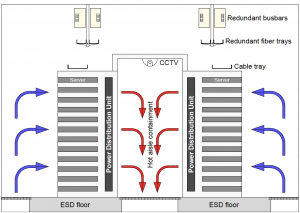That data centers supply power, cooling and security is clear, but how about the way the customers receive the power? Is there a best practice? In this blog I will share my vision regarding the use of busbar as a power distribution method for server racks.
Indifferently whether you’re using AC or DC power, you will need a transportation method to get the required power to your equipment. Basically, there are two options; firstly, independent cabling from a distribution panel to each rack, and secondly a Busbar running from a distribution panel to a corridor of racks.
Practical usage
For modern day data centers, cabled solutions are not advisable. Busbar offers a wider range of possibilities to be fully customized to the customers’ requirements. This really proves itself when you change your equipment, and you require different power configurations for your rack. When using cabling, a slow process of removing, migrating and installing new cables is most likely. Using Busbar, it only means installing a new tap box at the right position, migrate, and remove the ‘old’ tap box afterwards.
Time to market
A Busbar system allows data centers to quickly deploy power requirements for their customers. There is no need to wait for contractors to install the needed cables and plugs: just plug in the tap box on the Busbar, and within minutes the customer is live.
Pricing
At first sight, cables might look more cost effective, but when you calculate all requirements (present and future), a Busbar system is equally or lower priced. Cables are more labor-intensive, require pre-installed cable runners, and much more. When using them in the right configuration, Busbars can be used extremely efficiently: it’s possible to connect more than one cabinet to one tap off box or even reuse them. Damaged cables on the other hand, need to be replaced.
Datacenter.com uses a Schneider Canalis Busbar system that really improves our service to our customers. Ordering a new tap off box is just a matter of a day, our on-site team is able to install it 24 hours per day.

Datacenter.com AMS1 data center corridor side view
Conclusion
In my opinion a good data center will only use Busbar systems in their white space. The benefits for customers are much higher, for present day and future developments.
Pros and cons cabling
+ Cost-effective for small installations
+ Flexible in non-standardized setups
+ Can be installed by order
+ No maximum power limitation
– Requires contractors or electrical educated personnel to install
– Not future proof
– Long installation times and heavy labor
– Installation creates risks and dust
– Various hazards: Rodents, human error, toxic vapors when burning
Pros and cons busbar:
+ Fast time to market
+ Easy installation, only a short installation training is required
+ Requires less space
+ Tap off boxes can be tailor-made
+ Totally enclosed: protected from rodents, tamper, human error
+ No risks during installation of a tap off box
+ Possible to reuse components
+ Future proof
– Busbar needs to be pre-installed, which can cause initial CAPEX spending
– Not flexible in non-standardized datacenter layouts
– Power is limited to the size of the busbar
